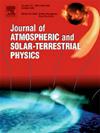Climatology and circulation classification of Saharan dust over Bulgaria
IF 1.8
4区 地球科学
Q3 GEOCHEMISTRY & GEOPHYSICS
Journal of Atmospheric and Solar-Terrestrial Physics
Pub Date : 2025-02-01
DOI:10.1016/j.jastp.2024.106403
引用次数: 0
Abstract
The Sahara is the largest hot desert in the world and produces more aeolian soil dust than any other desert. Saharan dust significantly impacts climate, biogeochemical, and hydrological processes. Additionally, Saharan dust strongly affects air quality and human health. As a result, it is important to monitor the frequency and the transport patterns of dust outbreaks. In this work, it is found that for the 10 years (2011–2020), there are a total of 365 days with Saharan dust transport over Bulgaria, with the number of days per year being between 16 and 53. The monthly climatology shows that the month with the largest number of days is March. The rarest transport of Saharan dust over Bulgaria is observed during the summer months. An objective classification of the atmospheric circulation on days with Saharan dust transport to Bulgaria is made for the period 2011–2019. Two objective circulation classifications — GrossWetter Types and Jenkinson–Collison Type with 26 types were used. The main circulation types with the transport of Saharan dust are associated with the development of Mediterranean cyclones and the transport of air masses from the south-southwest. A case study of Saharan dust intrusion into Bulgaria was made for the period from 25 to 27 March 2020. The specific synoptic conditions that lead to the transport of Saharan dust are discussed.
保加利亚撒哈拉沙尘的气候学和环流分类
撒哈拉沙漠是世界上最大的热沙漠,产生的风沙比其他任何沙漠都多。撒哈拉沙尘显著影响气候、生物地球化学和水文过程。此外,撒哈拉沙尘严重影响空气质量和人类健康。因此,监测沙尘爆发的频率和运输模式是很重要的。研究发现,在2011-2020年的10年中,保加利亚有撒哈拉沙尘输送的天数为365天,每年的天数在16 - 53天之间。月气候学显示,日数最多的月份是3月。在夏季的几个月里,在保加利亚上空观测到最罕见的撒哈拉沙尘运输。对2011-2019年期间撒哈拉沙尘输送到保加利亚的大气环流进行了客观分类。采用gross swetter型和Jenkinson-Collison型两种客观循环分类,共26种。与撒哈拉沙尘输送有关的主要环流类型与地中海气旋的发展和西南偏南气团的输送有关。在2020年3月25日至27日期间对进入保加利亚的撒哈拉沙尘进行了个案研究。讨论了导致撒哈拉沙尘输送的具体天气条件。
本文章由计算机程序翻译,如有差异,请以英文原文为准。
求助全文
约1分钟内获得全文
求助全文
来源期刊

Journal of Atmospheric and Solar-Terrestrial Physics
地学-地球化学与地球物理
CiteScore
4.10
自引率
5.30%
发文量
95
审稿时长
6 months
期刊介绍:
The Journal of Atmospheric and Solar-Terrestrial Physics (JASTP) is an international journal concerned with the inter-disciplinary science of the Earth''s atmospheric and space environment, especially the highly varied and highly variable physical phenomena that occur in this natural laboratory and the processes that couple them.
The journal covers the physical processes operating in the troposphere, stratosphere, mesosphere, thermosphere, ionosphere, magnetosphere, the Sun, interplanetary medium, and heliosphere. Phenomena occurring in other "spheres", solar influences on climate, and supporting laboratory measurements are also considered. The journal deals especially with the coupling between the different regions.
Solar flares, coronal mass ejections, and other energetic events on the Sun create interesting and important perturbations in the near-Earth space environment. The physics of such "space weather" is central to the Journal of Atmospheric and Solar-Terrestrial Physics and the journal welcomes papers that lead in the direction of a predictive understanding of the coupled system. Regarding the upper atmosphere, the subjects of aeronomy, geomagnetism and geoelectricity, auroral phenomena, radio wave propagation, and plasma instabilities, are examples within the broad field of solar-terrestrial physics which emphasise the energy exchange between the solar wind, the magnetospheric and ionospheric plasmas, and the neutral gas. In the lower atmosphere, topics covered range from mesoscale to global scale dynamics, to atmospheric electricity, lightning and its effects, and to anthropogenic changes.
 求助内容:
求助内容: 应助结果提醒方式:
应助结果提醒方式:


